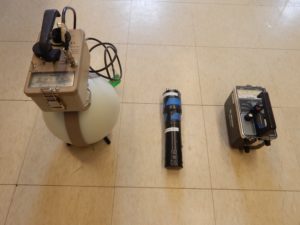Research Focus Areas: 5
Ph.D. Students: C.A. Miller
Collaborators:
Current neutron dose rate measurement methods rely on decades-old technology, resulting from a convenient relationship between thermal detector neutron response and dose effectiveness. This type of detector is sensitive only to neutrons, and is cumbersome to use and operate. We see an opportunity to use pulse shape discrimination capable organic scintillators to measure both neutron and photon dose rates. It is important to measure dose rates from both neutrons and photons in any environment where both particles are being produced. Current environments of interest include research with isotopic radiation sources, proton therapy treatment facilities, and research accelerator facilities.
There are many advantages for using organic scintillators in dose measurements. The relative ease of production and generalized dose conversion method allow for scaling the detector to a large range of sizes. The ease of separation between particle types also allows for measurement of both neutron and photons dose rates with one detector cell, instead of two separate instruments. This method is also applicable to a broad range of applications, due to spectroscopic capabilities over a large range of energies. Demonstration of this technique has been performed with liquid organic scintillators and stilbene crystals, using isotopic sources and secondary particles from proton therapy beams.
Related Conference Proceedings:
- C.A. Miller, M.A. Norsworthy, S.D. Clarke, S.A. Pozzi, R.W. Schulte, “Scintillator-based Measurement of off-Axis Neutron and Photon Dose Rates during Proton Therapy,” Poster Presentation, Institute of Electrical and Electronics Engineers Medical Imaging Conference, Strasbourg, France (Nov. 2016)
- C.A. Miller, S.D. Clarke, S.A. Pozzi, “Portable Fast Neutron and Photon Dose Meter,” American Association of Physicists in Medicine, Annual Meeting, Anaheim, CA, (July 2015)


